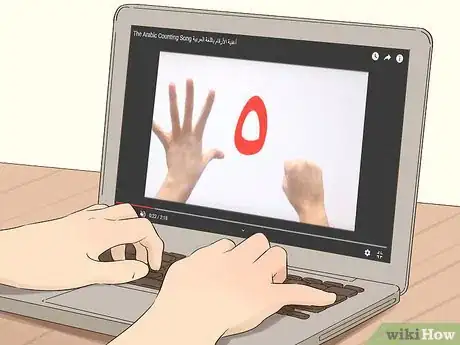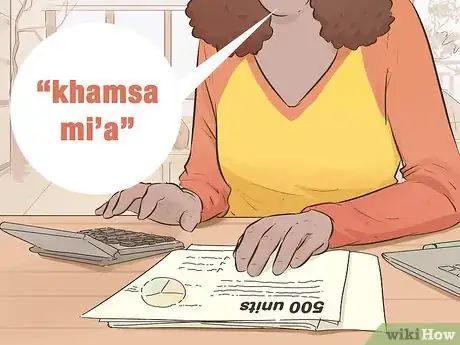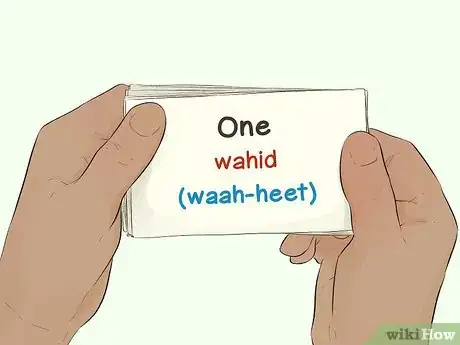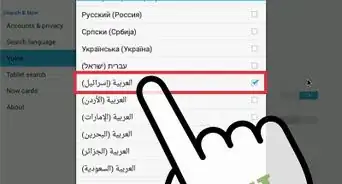This article was co-authored by wikiHow staff writer, Jennifer Mueller, JD. Jennifer Mueller is a wikiHow Content Creator. She specializes in reviewing, fact-checking, and evaluating wikiHow's content to ensure thoroughness and accuracy. Jennifer holds a JD from Indiana University Maurer School of Law in 2006.
This article has been viewed 502,566 times.
Learn more...
There are several different standard forms of Arabic that exist in different regions of the world where Arabic is spoken. Modern Standard Arabic (MSA) is the standardized version that most people learn. It is the official language of more than 20 countries, as well as one of the 6 official languages of the United Nations.[1] If you want to learn how to count to 10 in Arabic, the words will be the same regardless of the form. If you decide to move on to larger numbers, however, there may be some differences.
Steps
Counting to 10 in Modern Standard Arabic
-
1Start with the words for numbers 1 through 5. To count to 10 in Arabic, start with the first five numbers. Repeat the words until you have them memorized. You might use flashcards to help test your memory of the words.[2]
- One is wahid (waah-heet) (واحد).
- Two is itnan (ihth-naan) (إثنان).
- Three is talata (theh-lah-theh) (ثلاثة).
- Four is arba'a (ahr-uh-bah-ah) (أربع).
- Five is hamsa (hahm-sah) (خمسة). Note that the h has a guttural pronunciation. Imagine exhaling a strong, deep breath from the back of your throat as you say it.
-
2Move on to the words for numbers 6 through 10. Once you've got the first 5 numbers nailed down, you're ready to tackle the next 5. Practice them the same way you practiced the first 5, then put all 10 together to count to 10 in Arabic.[3]
- Six is sitta (siht-tah) (ستة).
- Seven is sab'a (sehb-uh-ah) (سبعة). Note that this sounds somewhat similar to the English word "seven."
- Eight is tamaniya (theh-mah-nee-yuh) (ثمانية).
- Nine is tis'a (tihs-anh) (تسعة). Speak the last syllable from further back in your throat.
- Ten is ashra (ahsh-ahr-rah) (عشرة). The r is ever so slightly clipped or rolled.
Advertisement -
3Say sifr (say-fur) (صفر) for "zero." The English word "zero" actually came from the Arabic word "sifr." The concept of zero originated in India and the Arab world and was brought to Europe during the Crusades.[4]
- Just as in English, the word for "zero" is not typically used in reading numbers, unless you're reading a list of cardinal numbers, such as a phone number or a credit card number.
-
4Learn to recognize Arabic numerals. Western numerals are frequently referred to as "Arabic" numerals. However, the numerals traditionally used in Arabic are more properly called Hindu-Arabic numerals, as they were imported from India.[5]
- The Hindu-Arabic numbers are 10 symbols or digits, representing the numbers 0 and 1 through 9: ٩ ٨ ٧ ٦ ٥ ٤ ٣ ٢ ١ ٠ . As in English, these 10 digits are combined to form every other number. So 10 would be a 1 and a 0, just as in English: ١٠ (10).
- Arabic is written and read right to left. However, Arabic numerals are written and read from left to right, just as you read English and other European languages.
Tip: In Mashreq countries (Iraq, Syria, Lebanon, Jordan, and Palestine), Arabic numerals are frequently used in conjunction with the Western numerals you already know.
Learning More Numbers
-
1Add the un suffix to the root digit name to make the words for the tens. Except for the number 10 (which you already know), all the words for even tens are constructed by replacing the last syllable of the word for the first digit with the suffix un. This is very similar to the way most of these words are formed in English, by taking the beginning of the first digit and adding the suffix ty.[6]
- Twenty (20) is ishrun. Note that you take the word for two, itnan, remove the last syllable, and replace it with un. The consonants ending the first syllable do change when writing the word using the Western alphabet.
- Thirty (30) is thalathun.
- Forty (40) is arba'un.
- Fifty (50) is khamsun.
- Sixty (60) is sittun.
- Seventy (70) is sab'un.
- Eighty (80) is thamanun.
- Ninety (90) is tis'un.
-
2Combine the digit with a form of the word for ten for 11 through 19. To form the words for the numbers 11 through 19, start with the word for the second digit in the number, then add the word ashar.[7]
- For example, 13 would be thalatha 'ashar. A literal translation would be "three and ten." All the other numbers from 11 through 19 follow this same formula.
-
3Use the tens word with the single digit for 21 through 99. To make compound words for larger numbers, use the word for the last digit, followed by the word for and and the connector wa-. Then add the proper word for the tens place.[8]
- For example, fifty-three (53) is thalatha wa-khamsun. The literal translation is the same as for the numbers 11 through 19. Thalatha wa-khamsun could be literally translated as "three and fifty."
-
4Use the word mi'a for numbers in the hundreds. Following a similar formula as the tens numbers, words for even hundreds are constructed by adding the word for 100, mi'a, after the multiplier digit.[9]
- For example, thalatha mi’a is 300.
Tip: Use the same formula as you used to form the words for numbers 21 through 99 to form the words for numbers in the hundreds.
Practicing Your Numbers
-
1Listen to counting songs to familiarize yourself with the words. There are many free videos, many of them designed for children, that will teach you how to count in Arabic. Sometimes a catchy tune is all you need to make the words stick.[10]
- To watch one such free video, check out https://www.youtube.com/watch?v=8ioZ1fWFK58. The playlist includes several other Arabic counting songs, so you can watch different ones until you find one you like.
Tip: Counting songs and videos can also help you practice pronunciation. Sing along or simply speak the words until you sound like the voice on the video.
-
2Download a mobile app to practice counting. Go to the app store on your phone and search for Arabic counting apps or multi-language counting apps (if you want to expand your knowledge beyond Arabic). Many of these apps are available for free.[11]
- For example, the app Polynumial translates numbers and helps you learn how to count. While the main app includes 50 different languages, there is also an Arabic-specific version. However, this app is only available for iPhones.
-
3Repeat in Arabic any numbers you encounter throughout the day. As you go about your day, you likely see and use numbers without really thinking about it. Each number you see, stop and try to translate it into Arabic. With practice, when you see the number your brain will automatically think of how to say it in Arabic.[12]
- For example, if you check your bank balance, try saying the number in Arabic. You can also do this with your step count, items in your grocery cart, number of minutes until lunchtime, or number of points in a sports game.
-
4Try counting flashcards to expand your Arabic vocabulary while you practice numbers. Basic counting flashcards, typically made for small children learning numbers, have a number of objects on one side and the number on the other. There's no reason you can't use these kinds of flashcards to practice Arabic counting.[13]
- You can purchase sets of flashcards online or at an educational store. There are also websites where you can download printable flashcards for free. Simply do a search for "free printable counting flashcards."
- Look up the word for the object online, then practice saying the word for the object along with the number of objects.
Community Q&A
Did you know you can get answers researched by wikiHow Staff?
Unlock staff-researched answers by supporting wikiHow
-
QuestionHow would you say one thousand eight hundred (1800) in Arabic?
 wikiHow Staff EditorThis answer was written by one of our trained team of researchers who validated it for accuracy and comprehensiveness.
wikiHow Staff EditorThis answer was written by one of our trained team of researchers who validated it for accuracy and comprehensiveness.
Staff Answer wikiHow Staff EditorStaff Answer
wikiHow Staff EditorStaff Answer -
QuestionCan someone write this in the Arabic numbers?
 Community Answer١ one, ٢ two, ٣ three, ٤ four, ٥ five, ٦ six, ٧ seven, ٨ eight, ٩ nine, ١٠ ten. As you can see, some numbers are similar to English numbers, such as the one and the nine.
Community Answer١ one, ٢ two, ٣ three, ٤ four, ٥ five, ٦ six, ٧ seven, ٨ eight, ٩ nine, ١٠ ten. As you can see, some numbers are similar to English numbers, such as the one and the nine. -
QuestionAre there any sites I can go to where I can hear someone counting out the numbers?
 Veronika BarchánkováCommunity AnswerTry Google Translator, which has a feature to read out loud anything you write.
Veronika BarchánkováCommunity AnswerTry Google Translator, which has a feature to read out loud anything you write.
References
- ↑ https://www.listenandlearn.org/blog/top-dialects-of-the-arabic-language/
- ↑ https://l-lingo.com/free-lessons/en/learn-arabic/numbers-1-10.html
- ↑ https://l-lingo.com/free-lessons/en/learn-arabic/numbers-1-10.html
- ↑ https://www.sciencefriday.com/articles/the-origin-of-the-word-zero/
- ↑ https://www.languagesandnumbers.com/how-to-count-in-arabic/en/arb/
- ↑ https://www.languagesandnumbers.com/how-to-count-in-arabic/en/arb/
- ↑ https://www.languagesandnumbers.com/how-to-count-in-arabic/en/arb/
- ↑ https://www.languagesandnumbers.com/how-to-count-in-arabic/en/arb/
- ↑ https://www.languagesandnumbers.com/how-to-count-in-arabic/en/arb/
About This Article
To count to 10 in Modern Standard Arabic, say Wahid, Itnan, Talata, Arba'a, Hamsa, Sitta, Sab’a, Tamaniya, Tis-a, Ashra. The R in Ashra should be slightly rolled. To help you learn the pronounciation of Arabic numbers, try listening to some counting songs online or using an app. For more tips, including how to count to 100 in Arabic, read on!





















-Step-3-Version-2.webp)













































